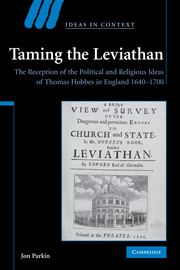 Taming the Leviathan
Taming the Leviathan Book contents
- Frontmatter
- Contents
- Acknowledgements
- Introduction
- 1 Reading Hobbes before Leviathan (1640–1651)
- 2 Leviathan (1651–1654)
- 3 The storm (1654–1658)
- 4 Restoration (1658–1666)
- 5 Hobbes and Hobbism (1666–1675)
- 6 Hobbes and the Restoration crisis (1675–1685)
- 7 Hobbism in the Glorious Revolution (1685–1700)
- Conclusion
- Bibliography
- Index
- Ideas in Context
5 - Hobbes and Hobbism (1666–1675)
Published online by Cambridge University Press: 05 May 2010
- Frontmatter
- Contents
- Acknowledgements
- Introduction
- 1 Reading Hobbes before Leviathan (1640–1651)
- 2 Leviathan (1651–1654)
- 3 The storm (1654–1658)
- 4 Restoration (1658–1666)
- 5 Hobbes and Hobbism (1666–1675)
- 6 Hobbes and the Restoration crisis (1675–1685)
- 7 Hobbism in the Glorious Revolution (1685–1700)
- Conclusion
- Bibliography
- Index
- Ideas in Context
Summary
The disasters of plague, fire and war that affected England between 1665 and 1667 ushered in a new and potentially very dangerous period for Hobbes. They would also herald a new phase in the reception of Hobbes's work, one that would see an explosion of allusion to Hobbes and his works within popular culture, as well as the creation of the popular image of Hobbes as the archetypal atheist philosopher and Leviathan as the handbook of irreligion and amorality. If discussion of Hobbes and Hobbism had seemed to go into abeyance after the philosopher's struggles with his academic critics in the 1650s, the later 1660s undoubtedly saw a renaissance in critical discussion of Hobbes's work and a popular reconstitution of his public image in many different contexts.
There were many connected reasons for the rise of Hobbesian discourse in the later 1660s, but there can be little doubt that it had an important relationship to the increasingly turbulent politics of the period. As earlier chapters have shown, the reception of Hobbes's work was often conditioned by the relationship between his ideas and the prevailing politics, and the situation in the later 1660s offers a complex example of this phenomenon. One factor central to the upsurge in Hobbesian discussion was the shift in the politics of the period. In the early Restoration period the basic alignment between crown, church and Parliament, fostered particularly by Clarendon and Sheldon, had allowed the suppression of the traditional centrifugal pressures that had traditionally plagued the Stuart polity.
- Type
- Chapter
- Information
- Taming the LeviathanThe Reception of the Political and Religious Ideas of Thomas Hobbes in England 1640–1700, pp. 238 - 311Publisher: Cambridge University PressPrint publication year: 2007


